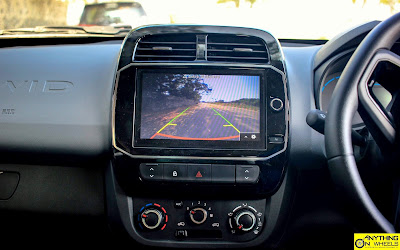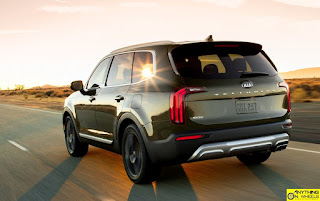Variant Tested: RXT(O) Easy-R
Price: ₹ 577,720 (On-road Chennai)
Not many car-makers gathered courage to set shop in India, take Maruti-Suzuki head-on with an entry-level hatchback and came out unscathed. Renault managed to do just that with the Kwid. With rugged looks and high-riding stance, the Kwid became such a hit that Maruti-Suzuki was forced back to the drawing board to come up with a rival. Renault, meanwhile, prepared the Kwid for the assault by giving it a facelift and more features.
We drove the new Kwid - in it's top-spec automatic avatar - to see if it still has a lot going for it.
A good-looking car just got better
Unlike most mid-cycle face-lifts, the Kwid gets a substantially redesigned fascia. Adopting split lights - a trend that's in vogue these days - the new Kwid creates a strong impression from the very first glance. The thin top clusters house LED daytime running lights along with the indicators. Between them is a rather large grille that emerges seamlessly with classy chrome strips at the top that seem like an extension of the LEDs. The redesigned bumper gets large headlights on black bezels that fill the gap nicely on either side of the air dam.
The revised front end aside, the Kwid facelift fits perfectly into the 'blink-and-you-miss' definition. Changes are hard to spot unless you have a keen eye. The hub caps get a new design, the sticker gets better colour-coded graphics, the reflectors at the rear are new and the taillight lenses get new detailing along with LED guide lights that look particularly impressive when illuminated. Smart incorporation of the reverse camera - that makes good use of the space in the brand's logo - is a neat touch as are the positioning of the badges.
The high-riding stance and the plastic cladding all around that gave the Kwid a mini crossover-ish appeal have been retained with the bigger 14-inch wheels complementing them.
Interiors were trend-setting once ...
When it was launched in 2015, the Kwid broke new ground as far as an entry-level hatchback's interiors go. Be it the space on offer or fancy things like the fully digital instrument cluster and the touchscreen infotainment system, Kwid had stuff cars from a segment or two above didn't. Forget the Alto 800 which was the Kwid's main rival at the time, even an EcoSport didn't have those features then. And the Ford was a feature-packed car itself! In the ensuing half-a-decade though, the competition has caught up, thanks in no small part to this car. Thank you, Renault.
... but are just par for the course now
Without a doubt, the Kwid's cabin is still a good place to be in. The dashboard is simple and well-designed, the layout is practical, space for passengers and their knick-knacks is sufficient and it's easy to get in and out of the car. It's these virtues that make you forgive the flimsy build at some places and the odd positioning of certain controls.
Step in and the nice almost-flat-bottomed steering wheel (Isn't this an economy car?) welcomes you. So does the neat-looking center console that stacks air-conditioning vents, a 8.0-inch touchscreen and miscellaneous switches and knobs one below the other. Subtle usage of chrome bits and piano black trims look pleasing to the eye. Other nice touches include the rotary gear selector that's now placed in the floor console and the chrome-plated door handles.
For an average Indian adult, the front seats are fairly supportive and overall visibility is satisfactory. The rear bench does its job pretty well too and can accommodate two adults and a kid without a fuss. The seats are a bit firm though and could do with a little more cushioning. While the driver and the front passenger gets a host of spots to store their stuff including multiple cup holders and slots, those seated at the rear don't even get a door pocket. Boot space is decent although the wheel arches intrude into the usable area.
Instrument Cluster:
The Kwid facelift continues with a full-digital cluster like it's predecessor. The good thing is it adopts a mature design that no longer looks like your kid's video game console. With a tachometer on the left and fuel and engine temperature displays on the right, the layout is tried and tested. What's unique is the absence of needles and how the digital bars appear to denote the current revs or fuel and temperature levels. The central display area shows the person behind the wheel all that's needed. The toggle button is well-positioned but look and feel cheap.
Infotainment System:
Touchscreens have become commonplace in entry-level cars now and the Kwid was one of the early influencers of the trend. With this facelift, Renault has one-upped itself and packed a 8.0-inch touchscreen infotainment system in this little car. The screen is quite responsive, easy to use, features all basic connectivity options and also doubles up as the reverse parking display. In the limited time we spent with the car, there was no lag to speak of and the interface left us impressed. The physical mute button and volume control knob are thoughtful additions.
What's the downside, you ask? Firstly, the screen was reflecting sunlight quite badly and it took a long, hard look with a tilted head and squinted eyes to find our way. Secondly, the speakers were strictly average - just like many other cars in this segment - and audiophiles would have to head straight to an accessories shop for an upgrade!
Renault has cut costs generously
Build quality, whilst acceptable for the most part, is not consistent and up to the mark elsewhere. The push-type door locks, glove-box lid and hood-release button are some of the many things where better quality materials would have helped. Another irritant is the location of power window switches that's sure to have first-timers fumble before they locate them in the center console. Did we tell you each wheel gets just three lug nuts to hold them in place?
Peppy engine is let down by the jerky AMT
The RXT version driven here gets the bigger 1.0-liter SCe engine under it's hood paired to an Automated Manual Transmission (AMT). In isolation, the 67 horsepower and the 91 Nm of torque this mill churns out is nothing to write home about. But factor in the car's weight of 750-odd kilograms and the perspective changes.
That's evident as soon as you get going. Turn the ignition on and the 3 cylinders under the hood make their presence felt. Refinement is not this car's forte. Rotate the dial into D, hit the accelerator and the car lunges ahead eagerly before the AMT pauses things momentarily, shifts up with its characteristic jerk and lets the car off the hook again. The mid-range is where this engine is at it's best and that's also where the AMT's intrusion is minimal and the jerks unnoticeable. Performance tapers off rather sharply once you hit the higher revs. Reaching triple digit speeds aren't a problem but cruising at those speeds all day isn't what this car is meant for.
The AMT's limitations are also felt when you engage or disengage the reverse gear. Move the dial from D to R and vice versa like you would do in any other car and the unit is caught off-guard. The AMT takes a few seconds to realize what's been asked of it before you hear that clunk. Nevertheless, the convenience offered by the AMT without compromising on fuel efficiency is undeniable.
Ride and handling impress
Renault has quite a reputation for the absorbent suspension and sure-footedness exhibited by it's cars. The Kwid, trust us, tries to stay true to those ethos and even partially succeeds. Low speed ride isn't the best and the car thuds over large potholes. The ride quality improves at moderate speeds where the vertical movements are well in control compared to some of its softly-sprung rivals.
Handling is a mixed bag too. Despite it's light weight and basic suspension hardware, the Kwid isn't unnerving to drive. Be it the car's eagerness to respond to lane change inputs in the city or it's ability to maintain composure out on the highway, the little Renault doesn't disappoint. Braking is adequate too though the pedal's long travel takes some time to adjust. What lets the car down however is the super-light steering that's devoid of feel. But hey, that's what people want!
Safety isn't neglected
In our eyes, the Kwid's biggest miss all along was the car's complete disregard to safety. Agreed, it's rivals fared no better but that's hardly an excuse. With this facelift, Renault has made amends on this aspect. Structural reinforcements are said to have been added to meet the Indian crash test norms and the car - in the top trim at least - can be had with Anti-lock Braking System (ABS), Electronic Brakeforce Distribution (EBD) and dual airbags.
With these changes, we hope the new Kwid fares better in the Global NCAP tests unlike it's predecessor that failed miserably - not once but thrice!
Specifications at a glance
To sum up
A major part of the Kwid's appeal since launch was it's refreshingly different take on an entry-level hatchback. Though cars like the S-Presso are vying for the same space now with similar attributes, the Kwid still has a lot going for it. The little Renault looks good, is spacious enough for a family, comes fully loaded and even has that all-important macho appeal. The erstwhile concerns on safety has been taken care of as well. The Kwid, then, is a budget choice you really can't go wrong with!
Text and Editing: Aravind Ramesh
Photography: Bharath Rengaraj / S. Keerthy





























